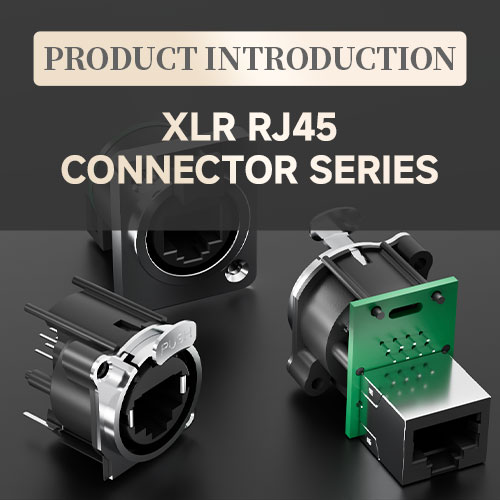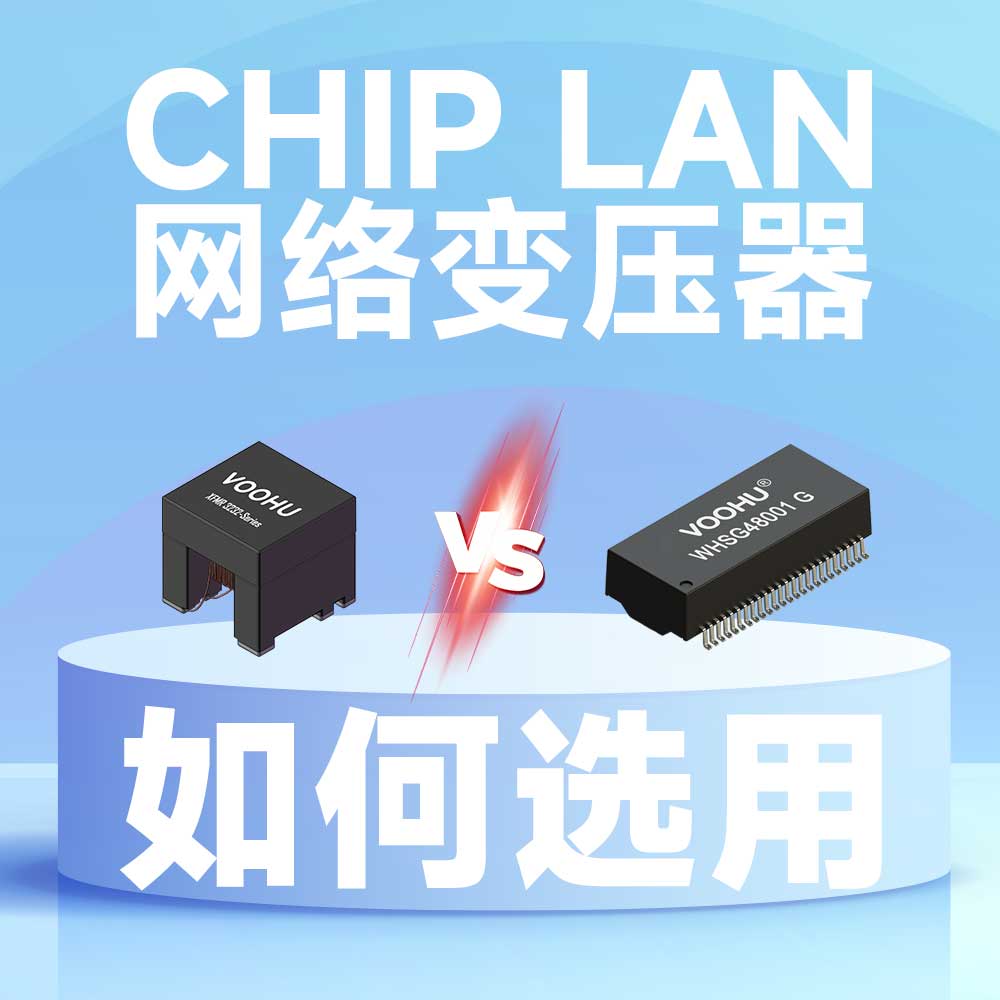Analysis of VOOHU Electronics RJ45 Connector
1. RJ45 Product Introduction and Material Composition
1. Product Introduction
RJ45 connectors are designed for terminating Ethernet cables and connecting computers, routers, local area networks and other types of data communication equipment
RJ45 (a registered jack interconnect) is a commonly used twisted pair connector, usually designed with eight positions and eight contacts (8P8C)
Our product portfolio includes RJ45 connectors in multi-port and single-port configurations, and adopts jack and plug modular connector styles. These parts are available in combined and stacked multi-port configurations as well as shielded and unshielded versions
The RJ45 interface dimensions produced by VOOHU Electronics strictly follow the FCC specifications for the RJ45 female 8P8C connector dimension specifications, and the main dimension standard screenshots are shown in the figure:
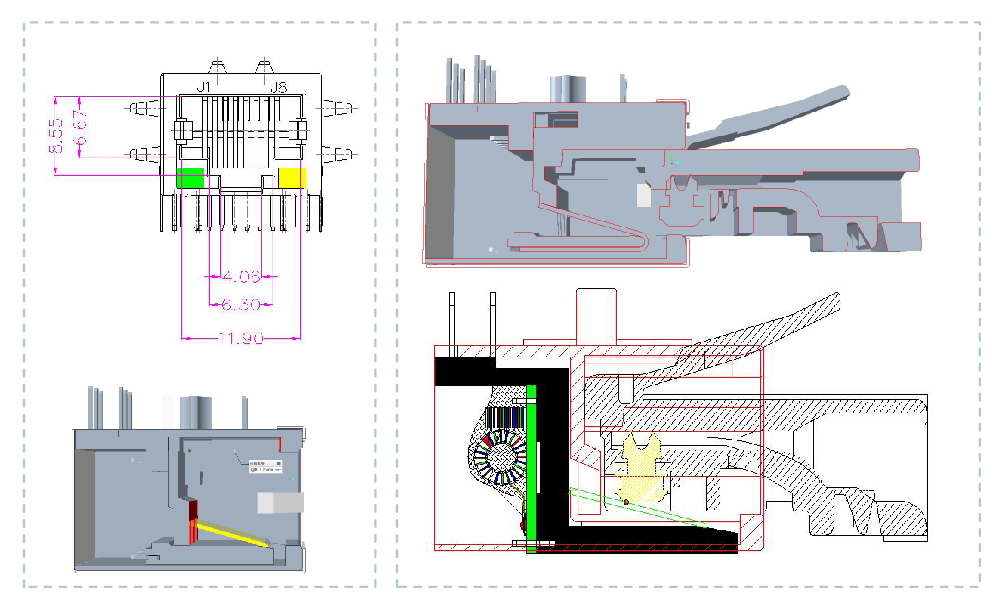
2. Material composition and product characteristics
The main material composition of the RJ45 network interface is shown in the figure below:

3. Product Features:
Shielded
Metal housing, providing EMI/RFI* protection. EMI/RFI* is unwanted electromagnetic energy (or "noise") within the frequency range commonly used in radio communications.
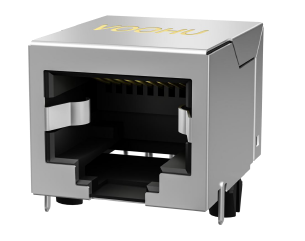 EMI — Electromagnetic Interference
EMI — Electromagnetic Interference
· RFI — Radio Frequency Interference
Grounding Options
Casing Ground - Contact with the casing for ground connection
PCB Ground - Contact with the PCB for ground connection
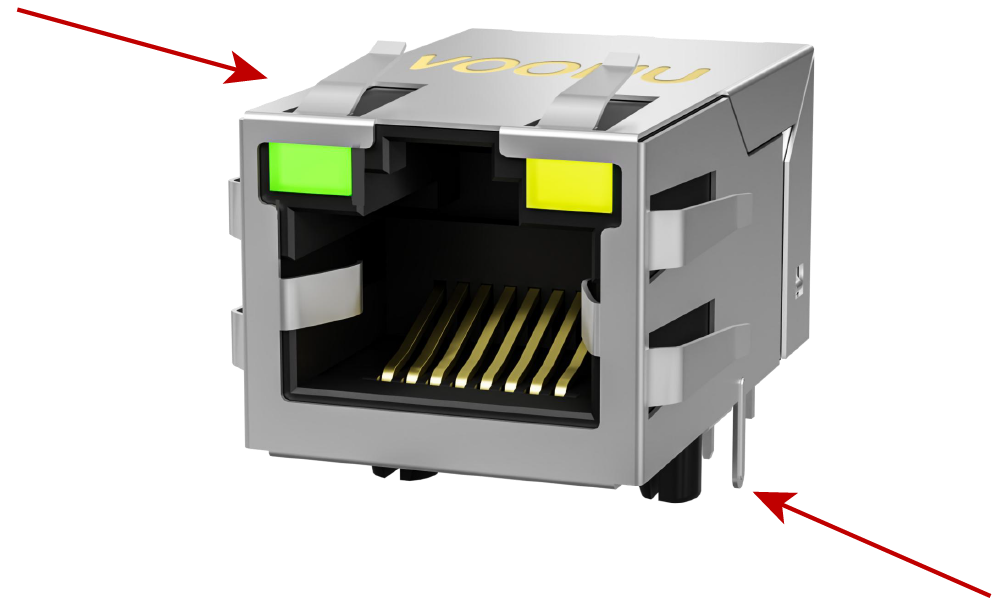
KEY(Interface)
Designed to be used with RJ45 male plugs to ensure proper mating, and can also accept standard plugs.
Mounting Pegs(Soldering Feet)
Provide board end soldering positioning and provide positioning and fixing support during the soldering process, but do not have board locking function. Most RJ45 female socket holes are equipped with some type of mounting pins.
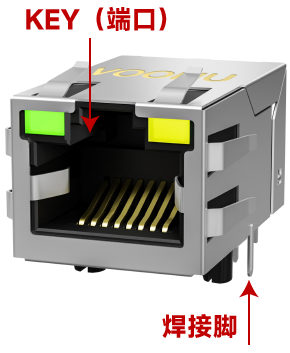 The ports are inverted
The ports are inverted
The contacts are on the bottom and the latch is on the top for easy plugging and unplugging.
Ports facing up
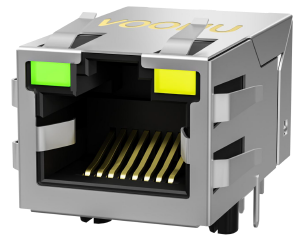
Ports facing down
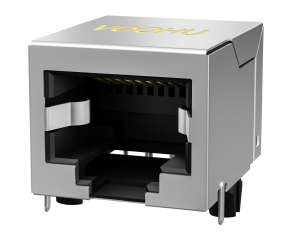
Panel Support Stops
Provide additional mechanical support, especially for top entry jacks.
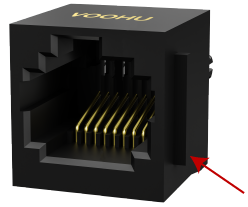
LED Light
Integrated into the female socket, no additional system space is required to install the indicator light. Available in a variety of colors and configurations.
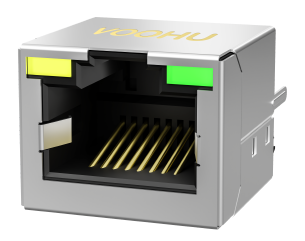
2. VOOHU RJ45 general product classification
1. Classification by port (single port, multi-port, stackable)
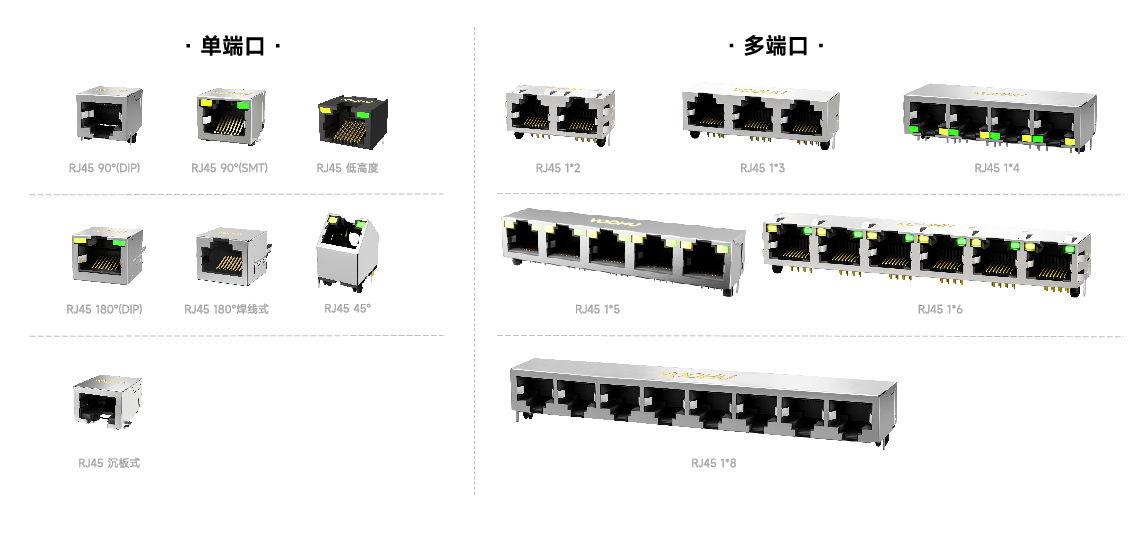
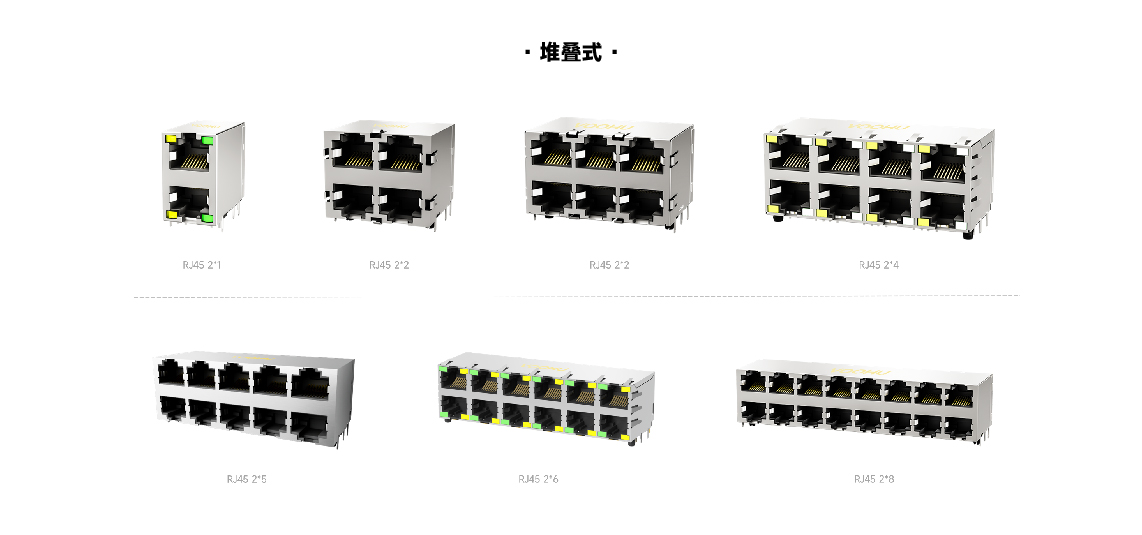
2. Classification by product rate (100M, 1000M, 5G, 5G, 10G)
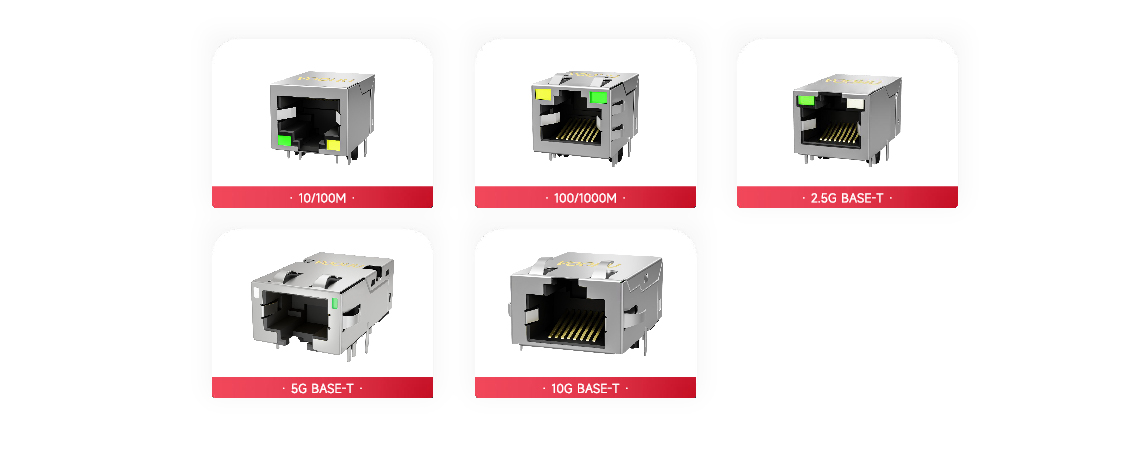
3. According to the mechanical structure of the product (integrated, separate, with/without shielding, with or without LED lights, port angles 90, 180, 45, sunken plate, plug-in, patch, regular height and low height)
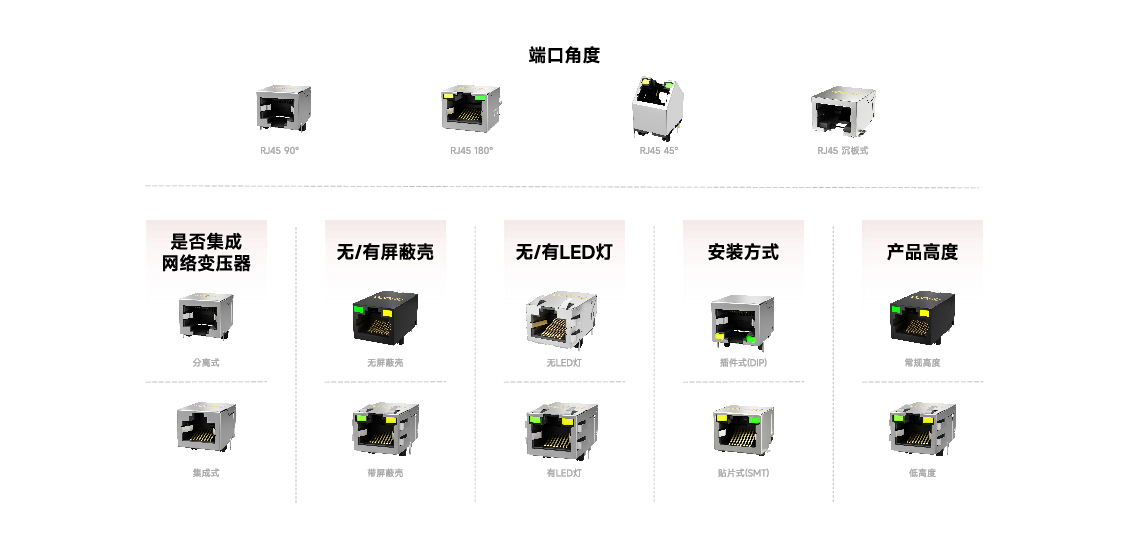
4. Special RJ45 product types
Classified by product application (waterproof RJ45, XLR RJ45 (panel mounted, onboard, with/without shielding, self-locking, snap-on), straight-through connector, RJ45 integrated with other interfaces)
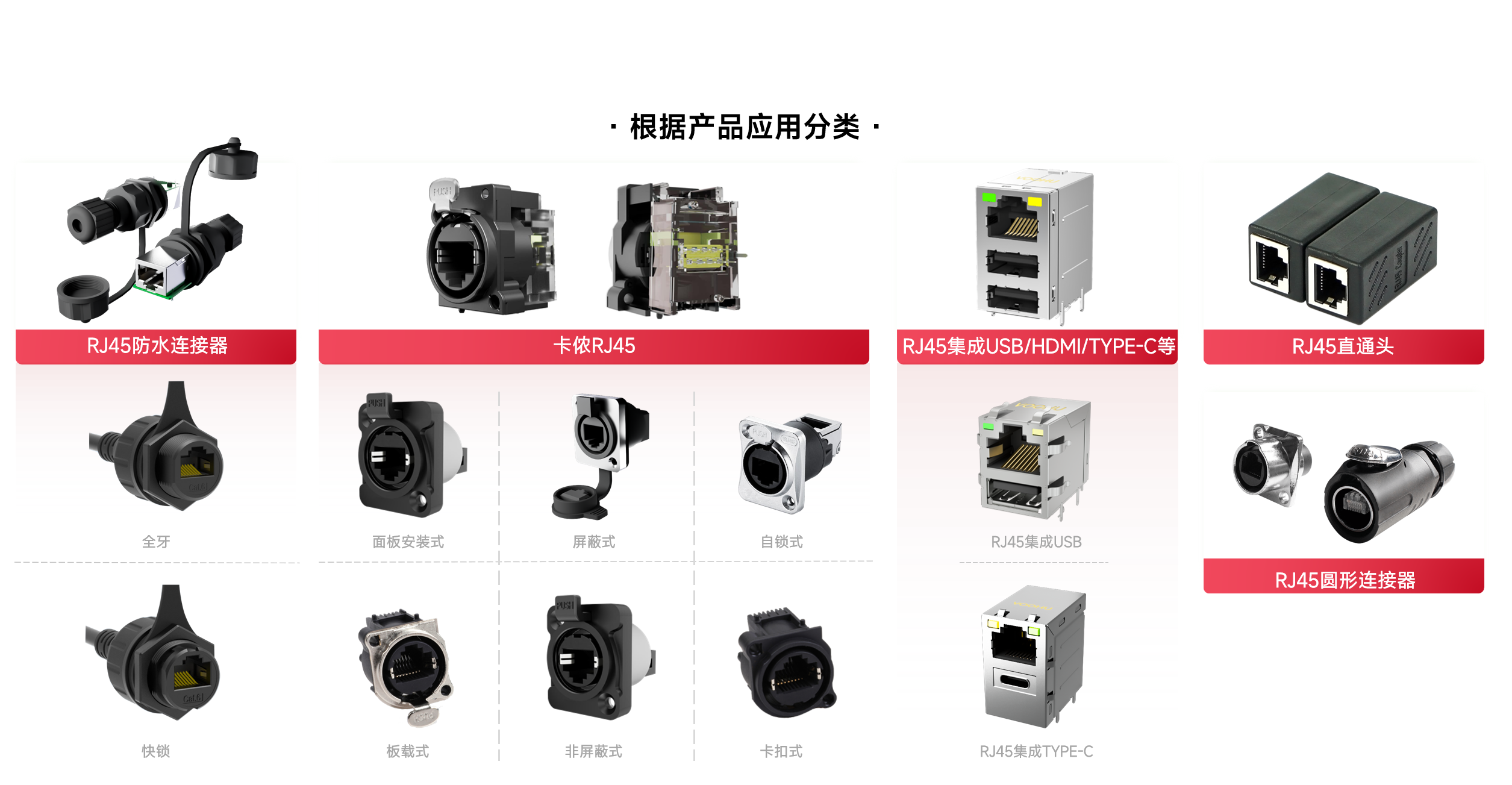
3. RJ45 selection suggestions
1. The difference between integrated and separate types and their respective applicable scenarios
The separate type (without transformer/without magnetic components) and integrated type (with network transformer/magnetic components) of RJ45 connectors are the core categories of PCB board-mounted female sockets. Their selection directly affects circuit design, cost, performance and applicable scenarios. The following is a detailed comparison of the two and an analysis of applicable scenarios:
1.1 Discrete Jack / Non-Integrated
Structural features:
No built-in network transformer, only RJ45 socket infrastructure (contact, housing, lock).
An independent network transformer module (usually SMD or DIP package) needs to be connected to the PCB.
Applicable scenarios:
·Industrial control and harsh environments
Industrial equipment (PLC, HMI, servo drive) needs to resist strong electromagnetic interference (EMI), and the external transformer can be placed away from the interference source.
Support a wider temperature range (-40°C~105°C) to avoid high temperature failure of magnetic components.
·High-power PoE++ equipment
For devices that support 802.3bt (90W) (such as APs and cameras), the external transformer has better heat dissipation to avoid magnetic saturation caused by overheating.
·Flexible design requirements
Transformer parameters (such as isolation voltage and common mode rejection ratio) need to be customized to meet high reliability scenarios such as medical/military use.
·Easy to repair and replace
When the transformer fails, only the independent module needs to be replaced, without disassembling the entire RJ45 socket.
Disadvantages:
Occupies a larger PCB area (transformer + socket), increasing layout complexity.
Need to purchase additional transformers, and supply chain management costs are higher.
1.2 Integrated RJ45 female socket (Integrated / Magnetics Jack)
Structural features:
Built-in network transformer and common mode choke to achieve signal filtering, electrical isolation and impedance matching.
Directly soldered on the PCB in a single module form (SMT or DIP package).
Applicable scenarios:
· Consumer electronics and small devices
Space-constrained products (routers, smart TVs, NAS), highly integrated to save PCB area.
· Standard Ethernet equipment
Cat5e/Cat6 applications such as commercial-grade switches, printers, IP phones, etc., with less environmental interference.
· Low-cost mass production requirements
Reduce the number of components, simplify the SMT patch process, and reduce assembly costs.
· Projects with short design cycles
No need to select a transformer separately, avoid impedance matching problems, and accelerate product launch.
Disadvantages:
Limited heat dissipation, high-power PoE++ (>60W) may overheat (industrial enhanced type must be selected).
The anti-interference ability is weaker than the separate type (the transformer is close to the socket and is easily affected by the chassis noise).
The entire device needs to be replaced in case of failure, and the maintenance cost is high.
The separate RJ45 female socket (external transformer) is suitable for harsh environments (industrial interference, high-power PoE, wide temperature), while the integrated RJ45 female socket (built-in transformer) is suitable for conventional equipment with limited space and cost sensitivity.
2. The difference between round pins and flat pins and their respective application scenarios
The keystone jack used for general network communication has 8 gold pins (contact pins, a metal wire with a surface coated with a layer of gold over nickel with a thickness of 50 microinches) installed inside the body to connect the 8 gold lock pieces installed on the network plug. Usually, the gold pins can be divided into two types: round pins with a cross-sectional area of 0.166190251mm2 and flat pins with a cross-sectional area of 0.12mm2, and the gold plating methods are also different.
Production process:
Round needles have always been made by drawing wires, and there is no waste in the manufacturing process. Since round needles have no directionality, they are easy to design for automated production;
Flat needles are produced by the material belt pulling the flat needles, but the material belt is no longer needed after the actual processing and use, so waste will be generated, and about 0.6 units of waste will be generated in 1 unit area
From the production process, the stamping process is much greater than drawing wires in terms of the production cost of round needles and flat needles
Gold plating cost:
Round needles use full plating technology, and flat needles can also set the range of contact between the top surface of the selected plating and the male head, thereby greatly reducing costs, but when facing automated production, it is necessary to overcome the problem of flat needle direction control
Mechanical performance and reliability:
Thanks to the physical structure of round pins, the pluggability and suitability for harsh environments of round pins are usually greater than those of flat pins, so round pins are often used in industrial equipment, while flat pins are often used in consumer electronic devices
Application scenarios of different pin pins:
Applicable scenarios of round pins:
Industrial equipment (PLC/industrial computer), Cat6A+/10G high-speed transmission, high-power PoE++ (≥60W), harsh environments such as vehicle/medical
Applicable scenarios of flat pins:
Consumer electronics (routers/printers), Cat5e/Cat6 standard Ethernet, low-power PoE (≤30W), cost-sensitive mass-produced products
3. Product differences with or without shielding shells
RJ45 connector plugs are divided into two types: unshielded and shielded. Unshielded RJ45 connector plugs are the most common type, with a simple structure and low price, suitable for general home and office environments where electromagnetic shielding requirements are not high. The shielded RJ45 connector plug has better anti-interference and anti-electromagnetic leakage capabilities, so it is widely used in occasions with high requirements for signal transmission quality and data security, such as finance, medical care, military, etc.
The shielded RJ45 connector plug is covered with a shielding layer on the periphery, which can effectively reduce the impact of external interference on signal transmission and improve the stability and accuracy of data transmission. At the same time, the shielded RJ45 connector plug can also prevent electromagnetic wave leakage and protect the security of user data. Although the appearance of the shielded RJ45 connector plug is no different from that of the unshielded plug, its role is very important in actual use.
IV. Product reliability verification project
1. The difference between integrated and separate types and their respective applicable scenarios
Test case based on integrated RJ45 gold-plated 6u"
Electrical test passed
·Contact resistance test
·Insulation resistance
·High voltage resistance
·Insertion force and life test;
·TR test
·Mechanical shock/drop test
·Solderability, solder resistance, LED test
·Single PIN elastic force
·Vibration test
Harsh environment test passed
·Humidity resistance/constant temperature and humidity
·Temperature resistance test/temperature life
·Salt spray 24H test;
·Cold resistance
5. Customization process of non-standard products
Customization case of tightness inside network port
A customer used a customized male plug and found that the plug was loose after connecting to our sample. He then confirmed the demand with our technicians. Our technicians customized the mold according to the demand, completed the delivery of the new demand sample within the specified time and passed the test, and implemented mass production and stocking.
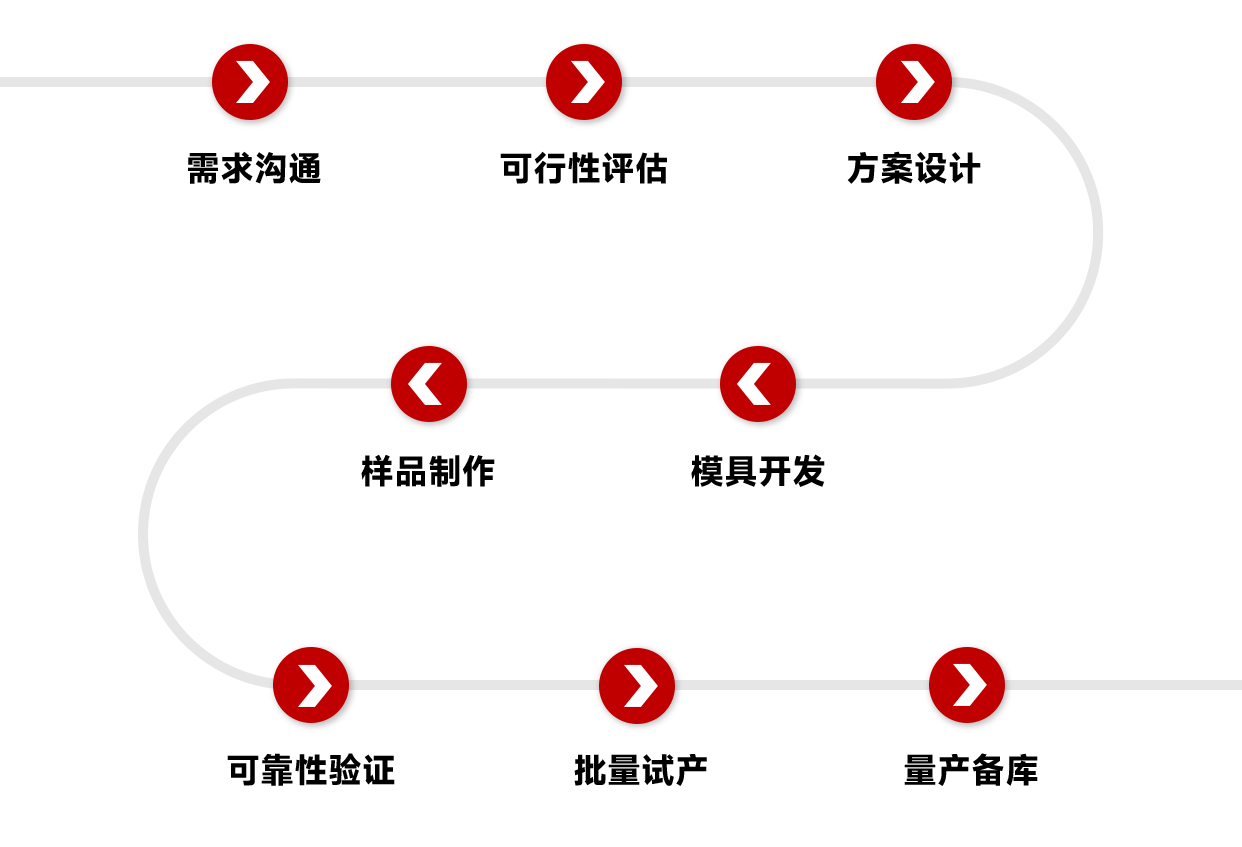
VI. Product application scenarios
Applicable to various industrial equipment and consumer electronics applications with RJ45 connection
Industrial applications requiring Ethernet
Industrial control, data communication, consumer electronics, photovoltaic energy storage, security monitoring, video control and other fields
VII. Reference design principles
1. Voltage type PHY+network transformer+RJ45
100 Base-T discrete conventional circuit

2. Voltage-driven PHY+RJ45 integrated 100M filter
Connected with voltage-driven PHY, the Bob-Smith circuit has the following functions:
1. Surge protection
2. Impedance matching
3. Reduce EMC radiation
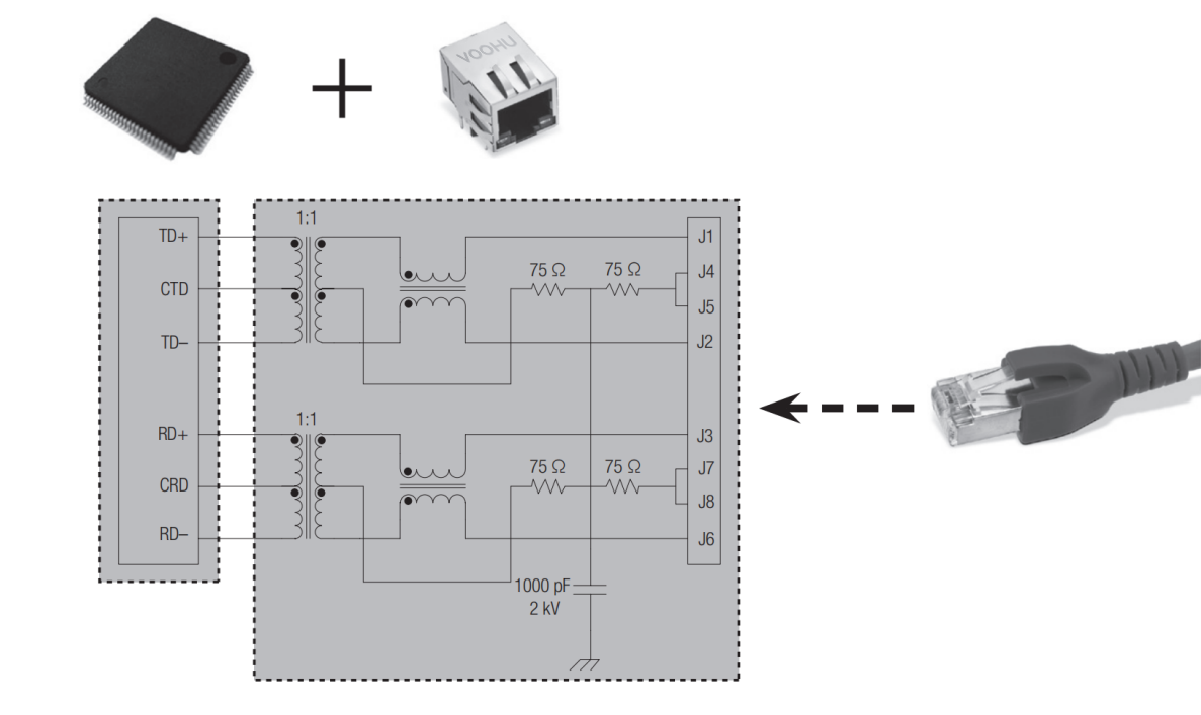
3. Current-type PHY+RJ45 integrated gigabit filter
The center tap connected to the current-driven PHY is pulled up to Vdd, which is the operating voltage of the PHY, and then connected to the ground capacitor (0.01uF - 0.1uF);
The most conspicuous here is the 50Ω resistor from the data line to the ground, located between the integrated RJ45 and the PHY. The reason is that there is a high-impedance amplifier at the entrance of the PHY, and the resistor prevents the data signal from reflecting on the signal line.
To prevent transient voltage overload, a TVS diode can be used between the integrated RJ45 and the PHY.
The distance between the PHY and the RJ45 needs to be as short as possible.
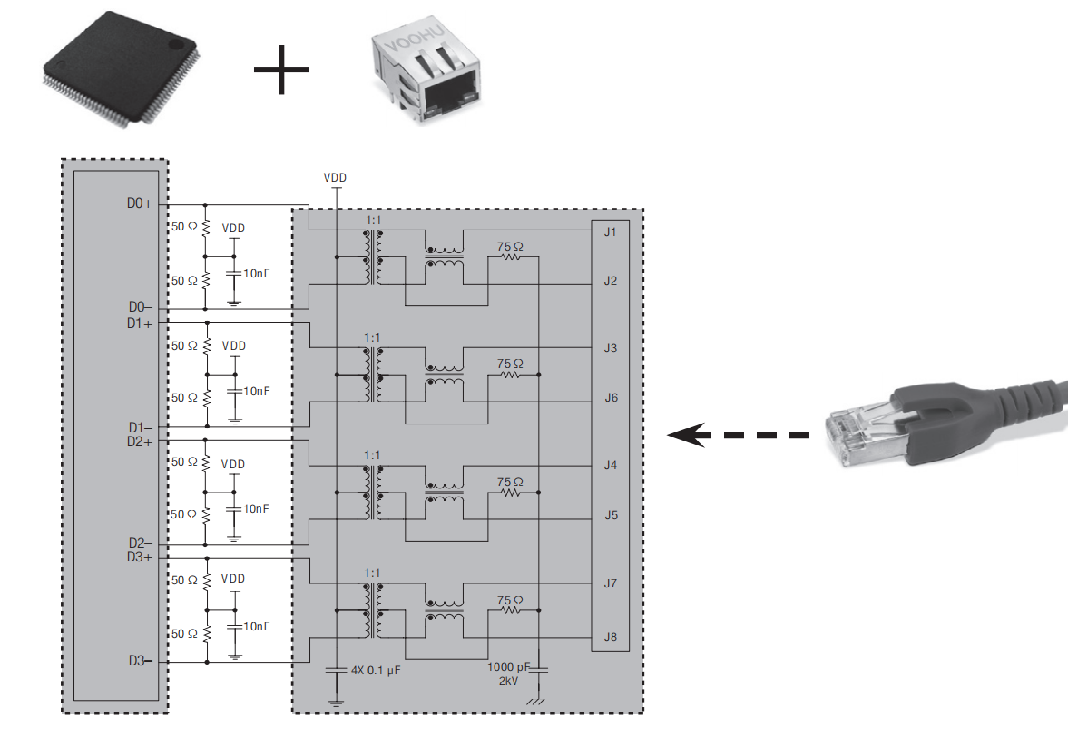
4. Voltage-type PHY+RJ45 integrated 100M filter (POE)
POE can provide energy for external peripheral devices. The figure shows a voltage source, which is called PSE (power supply equipment) here
First, the power supply voltage will be combined with the data signal. The current-driven 1000 Base-T diode bridge is the reverse polarity protection of the power supply device (PD)
In the schematic diagram, it is drawn next to the power supply device. If the risk of common-mode noise is high, it is recommended to place an additional common-mode choke in the PoE line.

1. Product Introduction
RJ45 connectors are designed for terminating Ethernet cables and connecting computers, routers, local area networks and other types of data communication equipment
RJ45 (a registered jack interconnect) is a commonly used twisted pair connector, usually designed with eight positions and eight contacts (8P8C)
Our product portfolio includes RJ45 connectors in multi-port and single-port configurations, and adopts jack and plug modular connector styles. These parts are available in combined and stacked multi-port configurations as well as shielded and unshielded versions
The RJ45 interface dimensions produced by VOOHU Electronics strictly follow the FCC specifications for the RJ45 female 8P8C connector dimension specifications, and the main dimension standard screenshots are shown in the figure:

2. Material composition and product characteristics
The main material composition of the RJ45 network interface is shown in the figure below:

3. Product Features:
Shielded
Metal housing, providing EMI/RFI* protection. EMI/RFI* is unwanted electromagnetic energy (or "noise") within the frequency range commonly used in radio communications.
 EMI — Electromagnetic Interference
EMI — Electromagnetic Interference· RFI — Radio Frequency Interference
Grounding Options
Casing Ground - Contact with the casing for ground connection
PCB Ground - Contact with the PCB for ground connection

KEY(Interface)
Designed to be used with RJ45 male plugs to ensure proper mating, and can also accept standard plugs.
Mounting Pegs(Soldering Feet)
Provide board end soldering positioning and provide positioning and fixing support during the soldering process, but do not have board locking function. Most RJ45 female socket holes are equipped with some type of mounting pins.
 The ports are inverted
The ports are invertedThe contacts are on the bottom and the latch is on the top for easy plugging and unplugging.
Ports facing up

Ports facing down

Panel Support Stops
Provide additional mechanical support, especially for top entry jacks.

LED Light
Integrated into the female socket, no additional system space is required to install the indicator light. Available in a variety of colors and configurations.

2. VOOHU RJ45 general product classification
1. Classification by port (single port, multi-port, stackable)


2. Classification by product rate (100M, 1000M, 5G, 5G, 10G)

3. According to the mechanical structure of the product (integrated, separate, with/without shielding, with or without LED lights, port angles 90, 180, 45, sunken plate, plug-in, patch, regular height and low height)

4. Special RJ45 product types
Classified by product application (waterproof RJ45, XLR RJ45 (panel mounted, onboard, with/without shielding, self-locking, snap-on), straight-through connector, RJ45 integrated with other interfaces)

3. RJ45 selection suggestions
1. The difference between integrated and separate types and their respective applicable scenarios
The separate type (without transformer/without magnetic components) and integrated type (with network transformer/magnetic components) of RJ45 connectors are the core categories of PCB board-mounted female sockets. Their selection directly affects circuit design, cost, performance and applicable scenarios. The following is a detailed comparison of the two and an analysis of applicable scenarios:
1.1 Discrete Jack / Non-Integrated
Structural features:
No built-in network transformer, only RJ45 socket infrastructure (contact, housing, lock).
An independent network transformer module (usually SMD or DIP package) needs to be connected to the PCB.
Applicable scenarios:
·Industrial control and harsh environments
Industrial equipment (PLC, HMI, servo drive) needs to resist strong electromagnetic interference (EMI), and the external transformer can be placed away from the interference source.
Support a wider temperature range (-40°C~105°C) to avoid high temperature failure of magnetic components.
·High-power PoE++ equipment
For devices that support 802.3bt (90W) (such as APs and cameras), the external transformer has better heat dissipation to avoid magnetic saturation caused by overheating.
·Flexible design requirements
Transformer parameters (such as isolation voltage and common mode rejection ratio) need to be customized to meet high reliability scenarios such as medical/military use.
·Easy to repair and replace
When the transformer fails, only the independent module needs to be replaced, without disassembling the entire RJ45 socket.
Disadvantages:
Occupies a larger PCB area (transformer + socket), increasing layout complexity.
Need to purchase additional transformers, and supply chain management costs are higher.
1.2 Integrated RJ45 female socket (Integrated / Magnetics Jack)
Structural features:
Built-in network transformer and common mode choke to achieve signal filtering, electrical isolation and impedance matching.
Directly soldered on the PCB in a single module form (SMT or DIP package).
Applicable scenarios:
· Consumer electronics and small devices
Space-constrained products (routers, smart TVs, NAS), highly integrated to save PCB area.
· Standard Ethernet equipment
Cat5e/Cat6 applications such as commercial-grade switches, printers, IP phones, etc., with less environmental interference.
· Low-cost mass production requirements
Reduce the number of components, simplify the SMT patch process, and reduce assembly costs.
· Projects with short design cycles
No need to select a transformer separately, avoid impedance matching problems, and accelerate product launch.
Disadvantages:
Limited heat dissipation, high-power PoE++ (>60W) may overheat (industrial enhanced type must be selected).
The anti-interference ability is weaker than the separate type (the transformer is close to the socket and is easily affected by the chassis noise).
The entire device needs to be replaced in case of failure, and the maintenance cost is high.
The separate RJ45 female socket (external transformer) is suitable for harsh environments (industrial interference, high-power PoE, wide temperature), while the integrated RJ45 female socket (built-in transformer) is suitable for conventional equipment with limited space and cost sensitivity.
2. The difference between round pins and flat pins and their respective application scenarios
The keystone jack used for general network communication has 8 gold pins (contact pins, a metal wire with a surface coated with a layer of gold over nickel with a thickness of 50 microinches) installed inside the body to connect the 8 gold lock pieces installed on the network plug. Usually, the gold pins can be divided into two types: round pins with a cross-sectional area of 0.166190251mm2 and flat pins with a cross-sectional area of 0.12mm2, and the gold plating methods are also different.
Production process:
Round needles have always been made by drawing wires, and there is no waste in the manufacturing process. Since round needles have no directionality, they are easy to design for automated production;
Flat needles are produced by the material belt pulling the flat needles, but the material belt is no longer needed after the actual processing and use, so waste will be generated, and about 0.6 units of waste will be generated in 1 unit area
From the production process, the stamping process is much greater than drawing wires in terms of the production cost of round needles and flat needles
Gold plating cost:
Round needles use full plating technology, and flat needles can also set the range of contact between the top surface of the selected plating and the male head, thereby greatly reducing costs, but when facing automated production, it is necessary to overcome the problem of flat needle direction control
Mechanical performance and reliability:
Thanks to the physical structure of round pins, the pluggability and suitability for harsh environments of round pins are usually greater than those of flat pins, so round pins are often used in industrial equipment, while flat pins are often used in consumer electronic devices
Application scenarios of different pin pins:
Applicable scenarios of round pins:
Industrial equipment (PLC/industrial computer), Cat6A+/10G high-speed transmission, high-power PoE++ (≥60W), harsh environments such as vehicle/medical
Applicable scenarios of flat pins:
Consumer electronics (routers/printers), Cat5e/Cat6 standard Ethernet, low-power PoE (≤30W), cost-sensitive mass-produced products
3. Product differences with or without shielding shells
RJ45 connector plugs are divided into two types: unshielded and shielded. Unshielded RJ45 connector plugs are the most common type, with a simple structure and low price, suitable for general home and office environments where electromagnetic shielding requirements are not high. The shielded RJ45 connector plug has better anti-interference and anti-electromagnetic leakage capabilities, so it is widely used in occasions with high requirements for signal transmission quality and data security, such as finance, medical care, military, etc.
The shielded RJ45 connector plug is covered with a shielding layer on the periphery, which can effectively reduce the impact of external interference on signal transmission and improve the stability and accuracy of data transmission. At the same time, the shielded RJ45 connector plug can also prevent electromagnetic wave leakage and protect the security of user data. Although the appearance of the shielded RJ45 connector plug is no different from that of the unshielded plug, its role is very important in actual use.
IV. Product reliability verification project
1. The difference between integrated and separate types and their respective applicable scenarios
Test case based on integrated RJ45 gold-plated 6u"
Electrical test passed
·Contact resistance test
·Insulation resistance
·High voltage resistance
·Insertion force and life test;
·TR test
·Mechanical shock/drop test
·Solderability, solder resistance, LED test
·Single PIN elastic force
·Vibration test
Harsh environment test passed
·Humidity resistance/constant temperature and humidity
·Temperature resistance test/temperature life
·Salt spray 24H test;
·Cold resistance
5. Customization process of non-standard products
Customization case of tightness inside network port
A customer used a customized male plug and found that the plug was loose after connecting to our sample. He then confirmed the demand with our technicians. Our technicians customized the mold according to the demand, completed the delivery of the new demand sample within the specified time and passed the test, and implemented mass production and stocking.

VI. Product application scenarios
Applicable to various industrial equipment and consumer electronics applications with RJ45 connection
Industrial applications requiring Ethernet
Industrial control, data communication, consumer electronics, photovoltaic energy storage, security monitoring, video control and other fields
VII. Reference design principles
1. Voltage type PHY+network transformer+RJ45
100 Base-T discrete conventional circuit

2. Voltage-driven PHY+RJ45 integrated 100M filter
Connected with voltage-driven PHY, the Bob-Smith circuit has the following functions:
1. Surge protection
2. Impedance matching
3. Reduce EMC radiation

3. Current-type PHY+RJ45 integrated gigabit filter
The center tap connected to the current-driven PHY is pulled up to Vdd, which is the operating voltage of the PHY, and then connected to the ground capacitor (0.01uF - 0.1uF);
The most conspicuous here is the 50Ω resistor from the data line to the ground, located between the integrated RJ45 and the PHY. The reason is that there is a high-impedance amplifier at the entrance of the PHY, and the resistor prevents the data signal from reflecting on the signal line.
To prevent transient voltage overload, a TVS diode can be used between the integrated RJ45 and the PHY.
The distance between the PHY and the RJ45 needs to be as short as possible.

4. Voltage-type PHY+RJ45 integrated 100M filter (POE)
POE can provide energy for external peripheral devices. The figure shows a voltage source, which is called PSE (power supply equipment) here
First, the power supply voltage will be combined with the data signal. The current-driven 1000 Base-T diode bridge is the reverse polarity protection of the power supply device (PD)
In the schematic diagram, it is drawn next to the power supply device. If the risk of common-mode noise is high, it is recommended to place an additional common-mode choke in the PoE line.

share to
Related links
You may also like
Prev article
Next article
Newsletter subscription
Subscribe to our newsletter and stay updated on the latest information of our company and product.
Name
|
Subscribe
I agree that the information that I provide will be used in accordance with the terms of Voohu International Inc. Privacy & Cookies Policy











